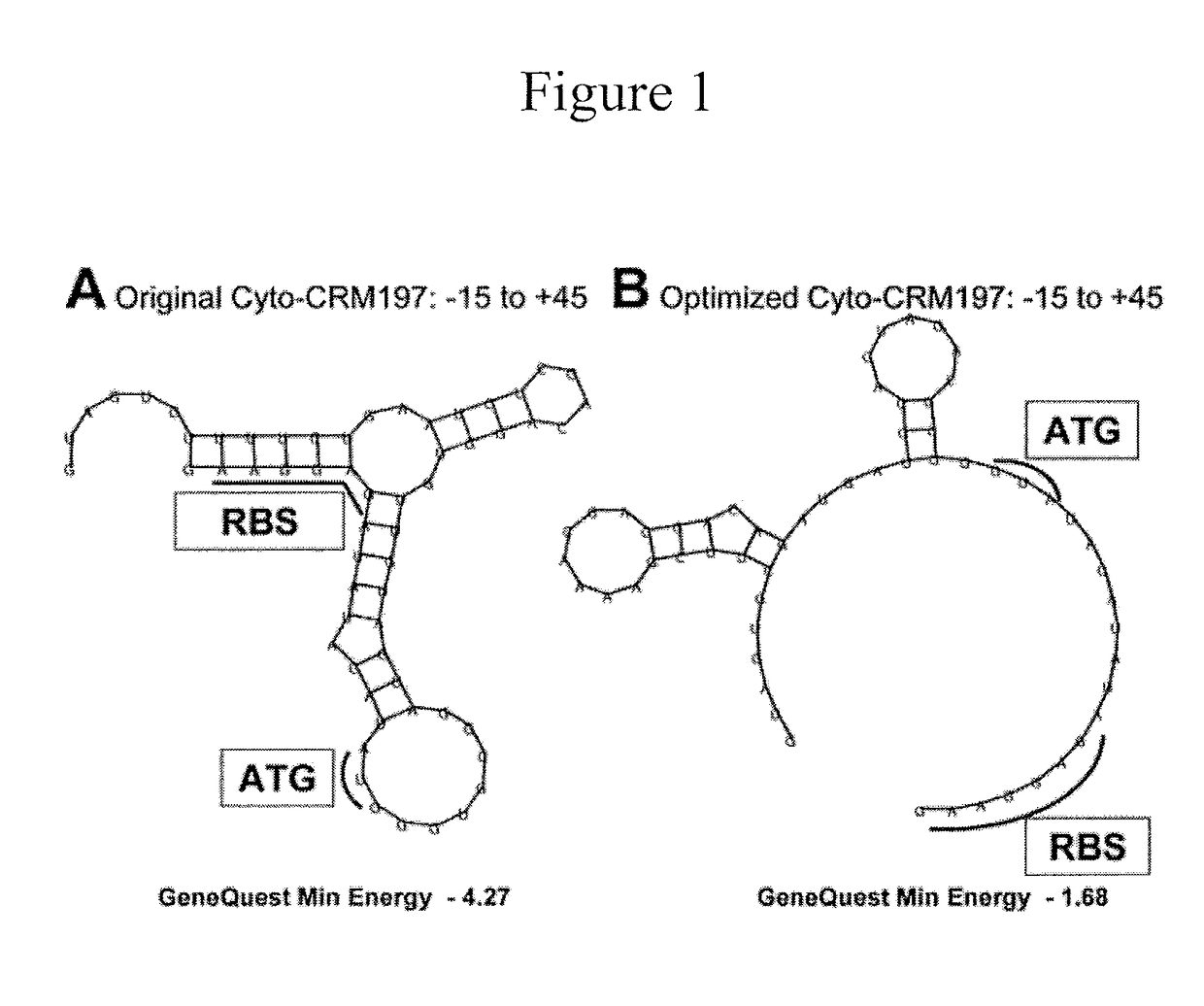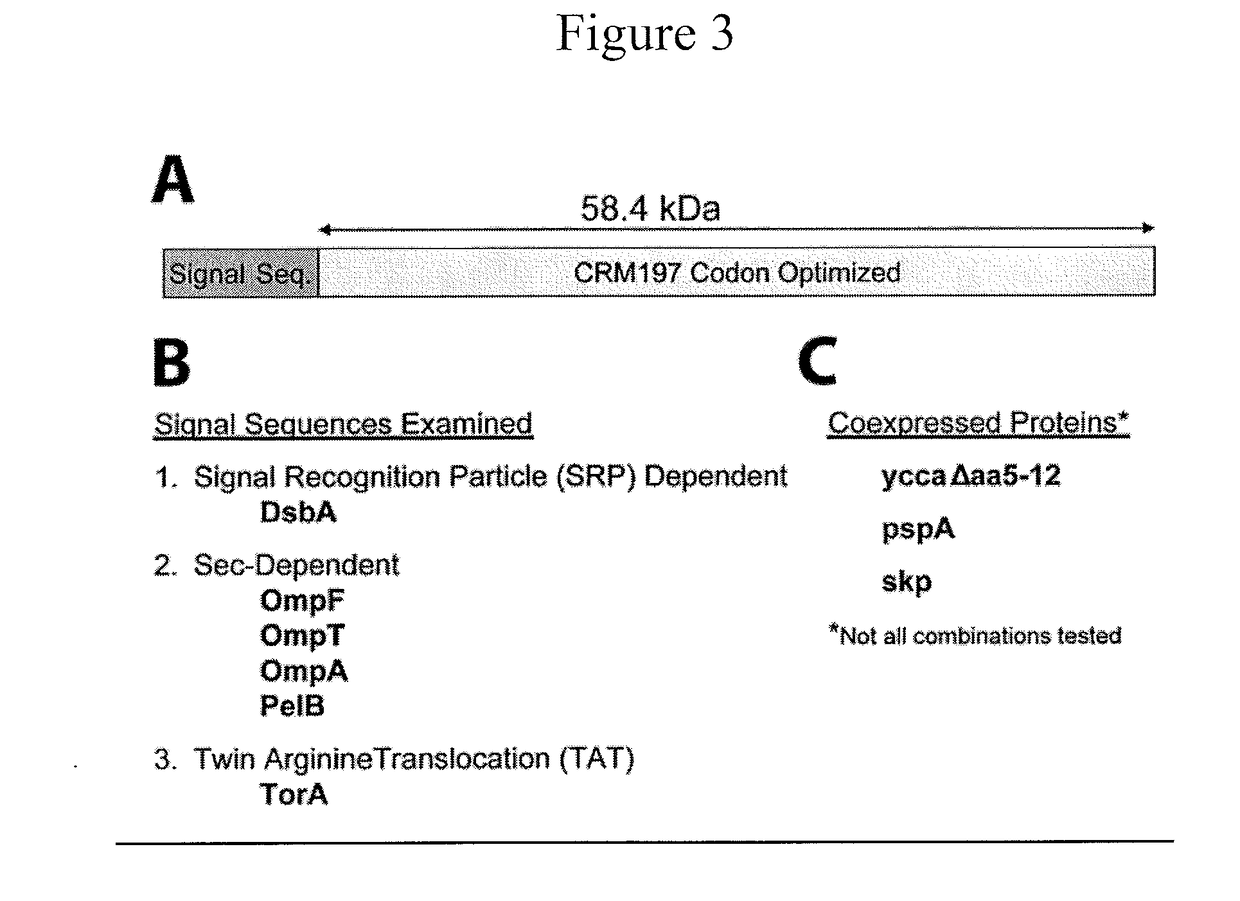Enhanced Production of Recombinant CRM197 in E. coli
a technology of e. coli and crm197, which is applied in the direction of nucleic acid reduction, organic chemistry, peptides, etc., can solve the problems of increasing the strain on current production methods, putting millions of children at risk, and cell death, and achieves relaxation of secondary structure enhancing recognition, the effect of minimal energy
- Summary
- Abstract
- Description
- Claims
- Application Information
AI Technical Summary
Benefits of technology
Problems solved by technology
Method used
Image
Examples
example 1
Cytoplasmic Expression of Insoluble CRM197 in Reduced Genome E. coli Hosts
[0093]CRM197 is currently manufactured by fermentation of Corynebacterium diphtheriae C7, where it is expressed from multiple lysogens of the β phage, or from a recombinant plasmid system in Pseudomonas fluorescens. The yield of CRM197 in C. diphtheriae is low (at most ˜200 mg / L) and requires biosafety level 2 (BSL2) facilities. Production in P. flurescens results in a higher yield (about 2 g / L); however, both hosts retain numerous mobile elements, cyrptic prophages and gene remnants with pathogenic functions. In bacterial fermentations, mobility of insertion sequence (IS) elements can lead to insertions that inactivate the gene of interest. The end result can be fermentation failure or the unwanted expression of a truncated product, both of which are economically problematic and potentially dangerous. In addition, reversion of CRM197 into its toxic parent could have disastrous consequences. Reversion of CRM19...
example 2
Periplasmic Expression of Soluble CRM197 in Reduced Genome E. coli Hosts
[0098]Next, production of soluble CRM197 in reduced genome E. coli strains was tested by directing expression of CRM197 to the periplasmic space. CRM197 has proved notoriously difficult to produce in a soluble form in E. coli. Export of highly expressed proteins to the periplasmic space aids stability by providing an optimal non-reducing environment for correct protein folding and formation of disulfide bridges. To this end, six signal sequences, in combination with a number of co-expressed chaperone proteins were examined to identify the signal sequence and chaperone protein that conferred the highest levels of periplasmic delivery of CRM197. FIG. 3 illustrates the signal sequences examined and the co-expressed chaperone proteins. The signal sequences examined included representative signal sequences from each of the three E. coli secretion pathways
[0099]The CRM197 open reading frame (ORF), codon-optimized for ...
example 3
CRM197 Production in Fed-Batch Fermentation
[0112]Next, commercial scale-up of CRM197 in reduced genome E. coli strains was examined. Thus, OmpA-CRM197 in the MDS42 metabolism strain was subjected to fed-batch fermentation in defined minimal media at the 10 liter scale. Fermentation conditions included a batch phase at 37° C. that was inoculated to 0.18 OD and allowed to grow until the 1% glucose in the batch medium has been consumed (˜7.5 hrs). The fed batch phase was triggered by the DO spike that occurs when the batch medium is depleted of glucose. The feed began with an exponential feed rate to produce a growth rate of 0.3 Mu (1 / h) controlled gravimetrically (˜12.5 hrs). The induction point was determined to be the point at which the available phosphate was nearly depleted. At a point around 2 hours prior to the induction point, the temperature was shifted to 25° C. and the feed rate was lowered to a rate that produces a growth rate of 0.2 Mu (1 / hr). Once the inducer is added (10...
PUM
| Property | Measurement | Unit |
|---|---|---|
| Temperature | aaaaa | aaaaa |
| Temperature | aaaaa | aaaaa |
| Temperature | aaaaa | aaaaa |
Abstract
Description
Claims
Application Information
 Login to View More
Login to View More - R&D
- Intellectual Property
- Life Sciences
- Materials
- Tech Scout
- Unparalleled Data Quality
- Higher Quality Content
- 60% Fewer Hallucinations
Browse by: Latest US Patents, China's latest patents, Technical Efficacy Thesaurus, Application Domain, Technology Topic, Popular Technical Reports.
© 2025 PatSnap. All rights reserved.Legal|Privacy policy|Modern Slavery Act Transparency Statement|Sitemap|About US| Contact US: help@patsnap.com



